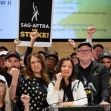The United Auto Workers union (UAW) announced on Friday that it would be expanding strike demonstrations after Detroit’s “Big Three” failed to reach a deal with union leaders.
The announcement came Friday morning from UAW President Shawn Fain, after automakers GM, Ford, and Stellantis failed to reach an agreement over worker wages and work conditions.
“At noon Eastern today, all parts distribution centers at General Motors and Stellantis will be on strike,” Fain said. “We will shut down parts distribution until those two companies come to their senses and come to the table with a serious offer.”
In announcing the expanded strike, Fain also recognized the progress of current negotiations. “We do want to recognize that Ford is serious about reaching a deal,” Fain said. “Stellantis and GM in particular are going to need some serious pushing.”
The UAW represents roughly 400,000 workers across different sectors. 146,000 of those union members work at one of the “Big Three” automaker plants; Ford, GM, and Stellantis.
In August, the UAW voted to strike after the Big Three failed to reach a collective bargaining agreement. Over the past week, auto workers took to the picket line, demanding better wages, benefits, and working conditions.
Under the National Labor Relations Act of 1935, workers have the right to participate in lawful strikes against their employers. There are two classes of lawful strikes. They include strikes that protest unfair labor practices in the workplace and strikes that are intended to fight against economic conditions.
For a lawful strike to take place, it must be done through what’s known as a “collective action.” Essentially, a group of just two individuals is enough to satisfy this requirement; however, the more people that participate in the strike, the more effective the strike will be.
The protections of the National Labor Relations Act of 1935 encompass large swaths of the private sector, although exceptions still exist. For example, workers in the railway and airline industry are covered instead by the Railway Labor Act. While striking is allowed under this law, it presents more obstacles a worker will have to overcome before striking. Generally, mediation through presidential or congressional intervention will usually take place before a strike occurs.
In the case of the UAW, the union is using an intentional “stand-up” strike method. This highly effective method pulls workers from specific auto plants, to keep from crippling the operations of the plants as a whole. The end result as is seen with the current auto strike allows for the biggest impact while minimizing UAW costs. Currently, strikes are happening at a Ford assembly plant in Wayne, Michigan, a GM factory in Wentzville, Missouri, and a Stellantis plant in Toledo, Ohio.
Although plants are still in operation, the ripple effect can be felt nationwide. Players in the supply chain including parts makers and suppliers have been left with declining business. Dealers have experienced a halt in new vehicle deliveries since the strike went into effect, and local shops and restaurants are feeling the burn of not having the business of auto workers who are currently on strike.
The auto strike is the first in the UAW’s 88-year history. Auto workers join writers and actors currently striking their industry. As with the writers and actors, the auto workers are demanding a share in the recent pattern of big profits. With the leadership of the UAW, auto workers have made it their mission to reap some of the benefits the Big Three have made pre and post-pandemic.
Included in the UAW’s demands are a 36% raise (down from the original 46% demand), a 32-hour work week, retirement healthcare, the reinstatement of traditional pensions that were lost during the Great Recession, and job security guarantees. Additionally, the UAW is also seeking protections for new hires under the current two-tiered pay system, who are paid much less than tenured workers.
After over a week of negotiations, the automakers have agreed to some of the demands, including a 20% wage increase from Ford and GM and a 17.5% wage increase from Stellantis. However, the UAW has declined these offers. If an agreement at UAW’s current asking is reached, it will be the largest rate increase in recent history. Currently, the UAW's top wage is $32.32 per hour after two 3% wage increases starting in 2019. The UAW’s demands would bring that wage up to $47.14.
During a Facebook livestream last week, UAW President Shawn Fain defended workers by explaining, "Big Three CEOs saw their pay spike 40% on average over the last four years. We know our members are worth the same and more."
Fain points to the staggering profits of the three companies by highlighting GM CEO Mary Barry’s 2020 compensation package which totaled nearly $29 million. Her earnings jumped 34% from 2019 while her base salary remained the same at $2.1 million.






